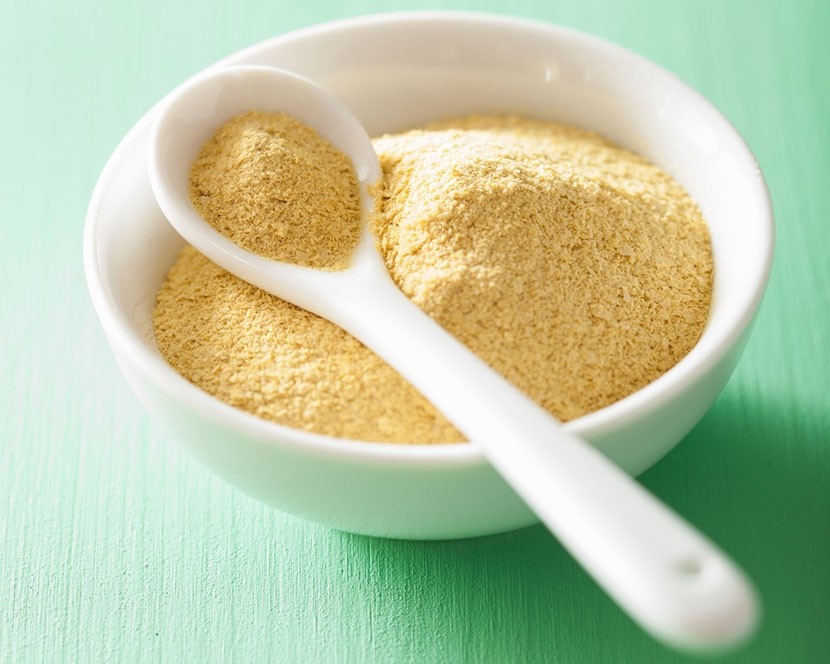Nutritional yeast, sometimes referred to as "nooch," has grown tremendously in popularity for those eating a diet free from animal products. Be that as it may, you may be asking yourself -- what the heck is nutritional yeast? Susan Voison, creator of FatFree Vegan Kitchen, has actually written an article with that title!
Susan explains that nutritional yeast is made from a single-celled organism called Saccharomyces cerevisiae that's grown on a food source such as sugarcane, beet molasses, or a mixture of the two. Before being harvested, nutritional yeast is deactivated (or killed) using heat. It is then washed, dried, and crumbled into flakes. Being deactivated, it cannot be used in baking as a leavening agent. Nutritional yeast is an optional ingredient in a plant-based diet and should not be confused with brewer's yeast which is used as a fermenting agent when making beer. Although they look very similar, they have very different flavors as well as nutritional profiles. Brewer's yeast is very bitter while nutritional yeast has a "cheesy" flavor. Because of this, nutritional yeast can be added to recipes when a "cheese-like" flavor is desired. You can find nutritional yeast in the dry bulk section of most large grocery stores and natural food stores. It is also available from many sources on the Internet. It comes in two different varieties, powdered or flaked. The flakes are preferred.
Although the primary purpose of nutritional yeast is the unique flavor it offers many dishes, nutritional yeast does contain several vitamins, minerals, B-complex vitamins and amino acids. The nutritional profile varies from one manufacturer to another. A few brands are fortified with Vitamin B-12, meaning Vitamin B-12 is produced separately and then added as a supplement. Despite this, nutritional yeast is not to be considered as a reliable source of B-12.
Most brands of nutritional yeast are "fortified" and enriched with synthetic vitamins. This becomes evident when comparing the nutritional values between fortified and unfortified brands. Due to the potential dangers associated with the synthetic form of folate (folic acid) and other synthetic vitamins, purchasing an unfortified brand is the healthiest option. It's very likely that the nutritional yeast found in the dry bulk section of your local grocery store is fortified with significant amounts of B vitamins, including folic acid. Look for brands that have "unfortified" on the label of their product. Click here or here for examples. Notice that nutritional yeast is the only thing listed in the ingredient list. The unfortified type contains naturally occurring vitamins and minerals without the associated health risks from synthetic folic acid. Additionally, according to Dr. Michael Greger, a few brands of nutritional yeast have tested positive for lead, but the lead content was found to be negligible.
Calorie content varies depending on the brand. Keep in mind that nutritional yeast is a calorie-dense, processed food. The calories can add up quickly and could interfere with your weight loss goals. Therefore, it is meant to be used sparingly as a condiment to enhance the flavor of your food. It's famous cheese-like flavor and concentrated taste makes it a highly palatable food, so it's easy to get carried away! Please see my Starch-Smart System for more details.
Nutritional yeast is a versatile ingredient. It can be used as a faux "Parmesan cheese" topping, in dips, sauces, and added to dishes like tofu scramble, scalloped potatoes and casseroles. You may enjoy trying many of Susan Voison's FatFree Vegan Kitchen recipes with nutritional yeast listed below:
Recipes by Susan Voison:
(1) Quick and Easy Potato Soup
(2) Pasta and Vegetables with White Sauce
(3) Vegan Scalloped Potatoes with Chickpea Cheese Sauce
(4) Black Bean and Summer Squash Enchiladas
(5) Ridiculously Easy Curry-Scrambled Tofu
(6) Swiss Chard with White Beans and Job’s Tears
Additional recipes:
